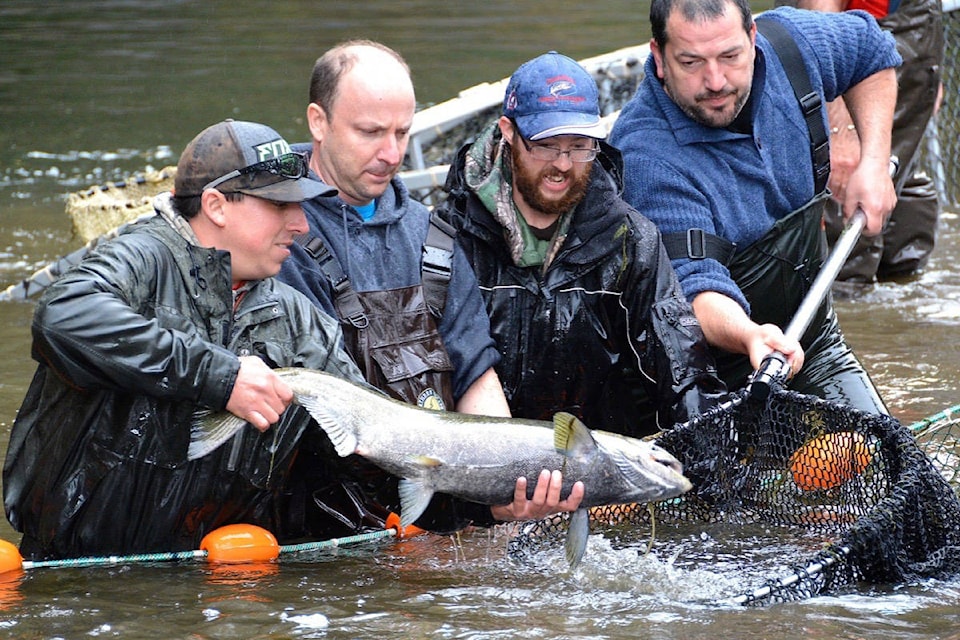The federal government is eyeing further cuts to recreational and commercial fisheries on the West Coast over conservation concerns for the Fraser River chinook salmon.
In a letter to First Nations and fisheries stakeholders, Jeff Grout, the Fisheries Department regional resource manager for salmon, said fewer fish are returning to the Fraser River and more conservation measures are needed.
Thirteen B.C. chinook salmon populations are declining, the Committee on the Status of Endangered Wildlife in Canada reported late last year. Southern B.C. has 28 chinook populations. Only one, in the Thompson River, is stable. The condition of two populations is unknown.
In 2018, the number of spawning salmon declined substantially in the Fraser River, Grout said. In addition, the fish were smaller compared to other years, fewer females, and reduced fertility.
The Fisheries Department has floated two scenarios in its approach to managing Fraser River chinook this year.
Scenario A would result in a non-retention of chinook salmon in the recreational fishery from April 1 to July 31. Scenario B could see some chinook retention – up to two a day.
RELATED: Feds limit chinook fishery to help killer whale recovery
Last spring, the Fisheries Department announced a ban on harvesting any fin-fish from Otter Point in Sooke to East Point, near Port Renfrew, a stretch of approximately 50 kilometres extended from the shoreline to U.S. waters, to protect endangered southern resident killer whales.
A representative with the Fisheries Department said that move was to preserve the chinook salmon population, which makes up most of the whales’ diet and to decrease noise in the area.
The ban went into effect last June and lasted until Sept. 30.
The South Vancouver Island Anglers Coalition recognizes the chinook conservation concern, said spokesman Chris Bos.
“We’re at a pivot point in attempts to maintain the fishery and address conservation,” he said. “We’re not trying to be greedy and catch all the fish.”
RELATED: West Coast urging DFO to consult more before shutting down sports fishery
For the last 15 years, the coalition has discussed conservation measures with the government.
The coalition says more focus is needed to bring the fish habitat back, money for it, and help the fish stock rebuild itself naturally.
“We also need to do something to protect the people who live on the coast, who rely on access to the ocean,” Bos said.
The South Vancouver Island Anglers Coalition says millions of dollars are injected into the local economy by the recreational fishing industry and commercial fishermen.
Environmental groups continue to argue that far more needs to be done concerning ongoing threats to the whales and salmon.
“There’s a greater economic impact if we lose these fish entirely,” said Jeffery Young, senior science and policy analyst with the David Suzuki Foundation.
“We support the measures (the Fisheries Department), which largely stop chinook salmon fishing in marine areas along the south coast.”
The foundation acknowledges many factors that have contributed to the chinook salmon crisis, including habitat destruction, a warming and acidifying ocean, wildlife predation, and fishing.
The goal, though, must be to rebuild the stocks and that will take drastic action, which should include no fish zones, the foundation says.
“We do understand how important chinook is to the recreational fishery, but other opportunities are out there (such as fishing other species), and there’s really no justification on a highly depleted and endangered stocks,” Young said.
Politician and fishing advocate Mike Hicks said whatever approach the Fisheries Department takes, either Option A or B, will be devastating to the local recreational fishery.
“This is the most aggressive regulation that’s ever suggested in the history of recreational and commercial fishing on the coast,” he said, conceding there isn’t enough chinook salmon in local waters.
Hicks suggested a need to curtail fishing, but added more needs to be done to produce salmon through improved habitation and more hatcheries.
Hicks is a proponent in the construction of a $1-million hatchery that’s expected to be running by next fall in Sooke. He said projects such as this will improve the number of salmon that make it safely to the ocean and return four years later.
He also favours reducing the number of seals in river estuaries.
The Pacific Salmon Foundation estimates harbour seals are eating 40 per cent of the salmon fry and smolts coming out of local rivers and streams.
“We should be harvesting pinnipeds in the river estuaries – not out in the ocean – but not a massive cull. It should be done by First Nations for food and ceremonial purposes.”
•••
The Fisheries Department is considering closures for the recreational chinook salmon fishery from April 1 to July 31. The following areas could be affected:
• Gabriola Island to Port Hardy
• Mayne Island to Bonilla Point
• Swiftsure Bank to Cape Scott
• Fraser River (tidal and non-tidal)
There is also a plan floated for a reduction for the commercial fishery in the West Coast troll area (Area G) and North Coast troll area (Area F)
editor@sookenewsmirror.com
Like us on Facebook and follow us on Twitter
